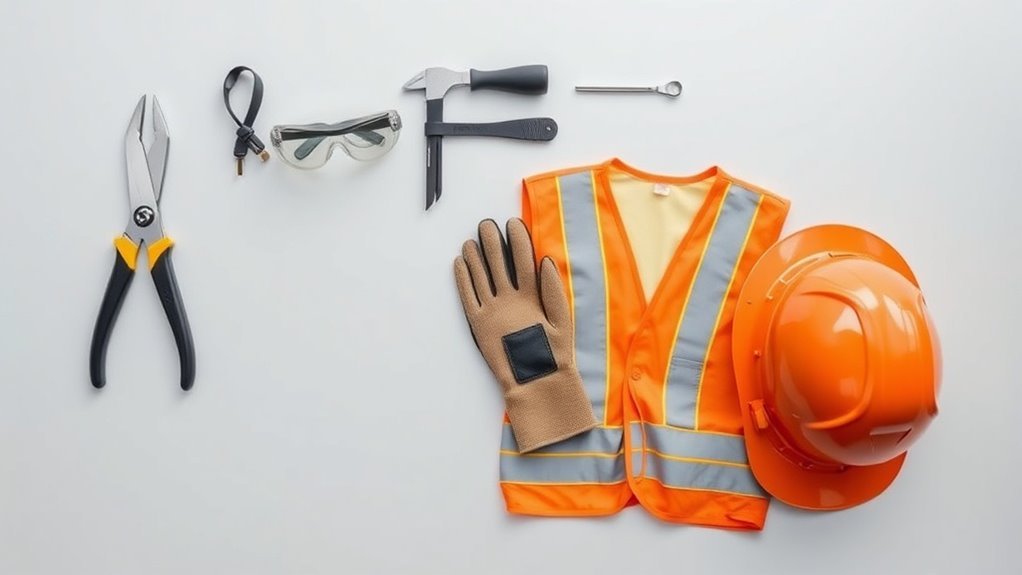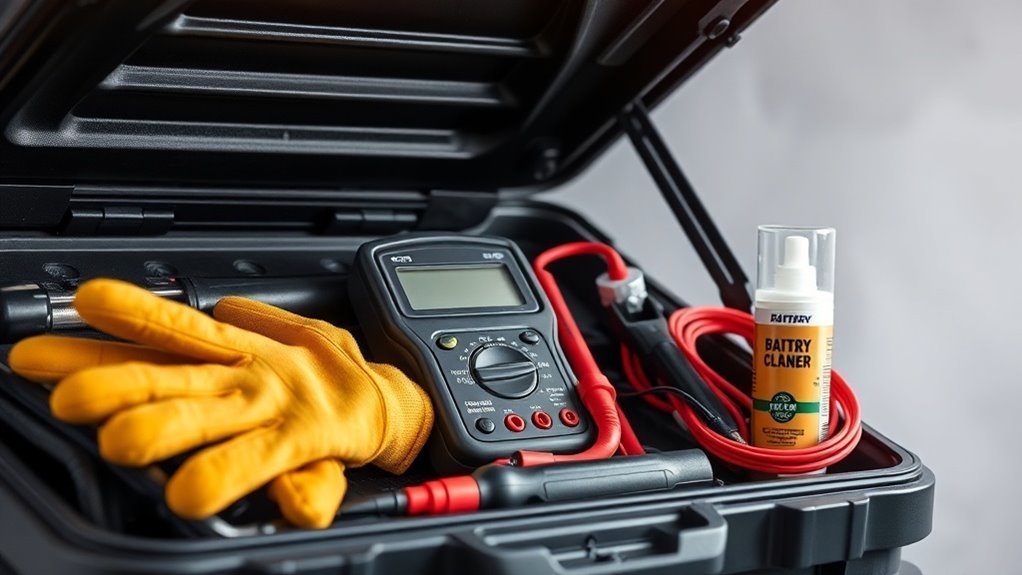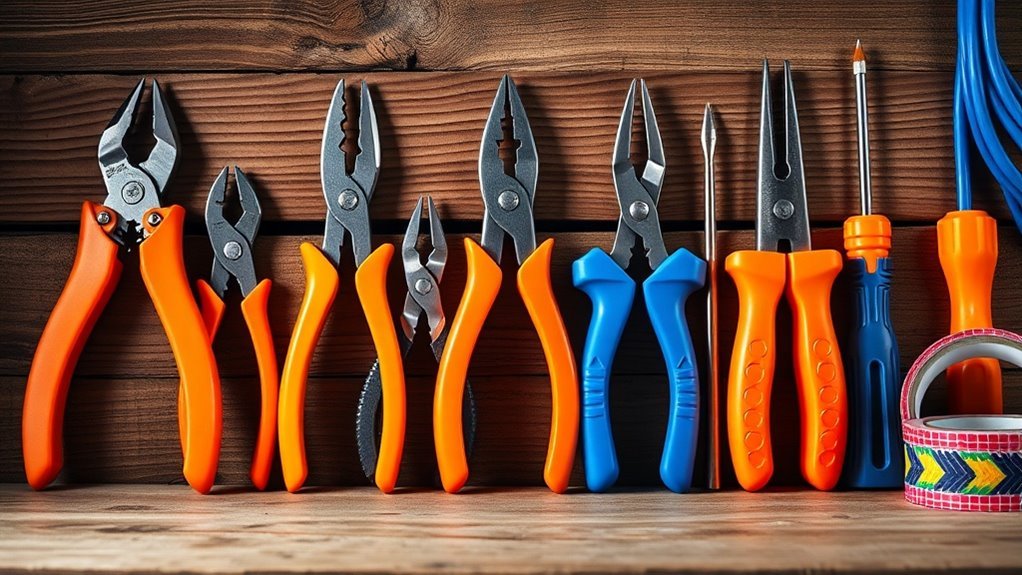Essential Safety Tools for Home Renovation Projects
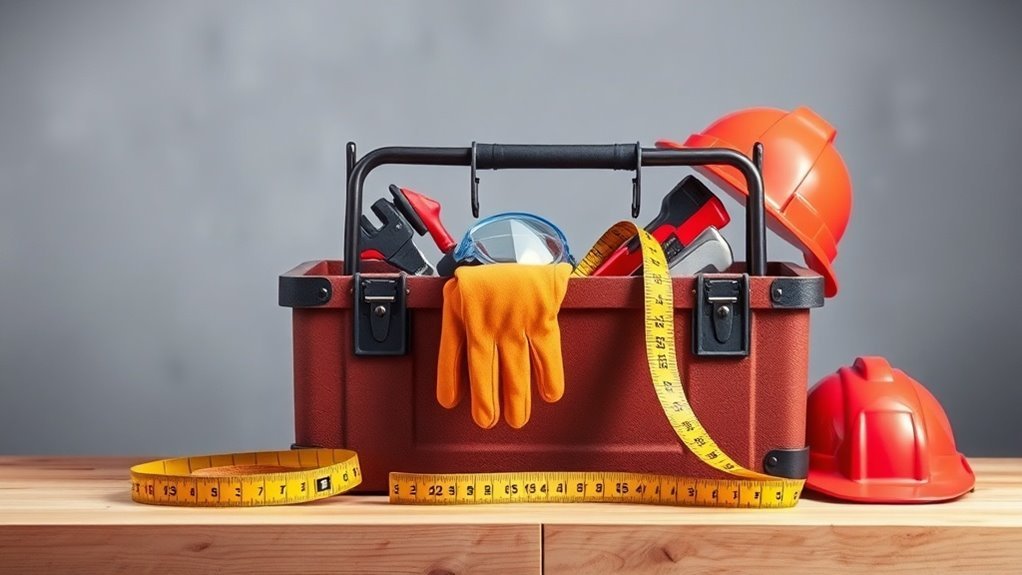
When tackling home renovation projects, you need essential safety tools to keep yourself protected. Equip yourself with personal protective equipment (PPE) like safety goggles, ear protection, and gloves. Dust masks and respirators are crucial for respiratory safety, while hard hats guard against overhead hazards. Don’t forget a first aid kit for any unexpected injuries and a fire extinguisher in case of emergencies. Stick around to discover more tips on keeping safe while you renovate your home!
Key Takeaways
- Invest in Personal Protective Equipment (PPE) like gloves, masks, safety goggles, and steel-toed boots for overall safety during renovations.
- Use safety goggles to protect your eyes from dust and debris; look for features like anti-fog and scratch-resistant lenses.
- Wear hearing protection, such as earplugs or earmuffs, to safeguard against loud tools and machinery during renovation projects.
- Keep a well-stocked first aid kit on hand with essential supplies to address any unexpected injuries or accidents efficiently.
- Check and maintain fire extinguishers regularly to ensure they are accessible and effective in case of fire hazards during renovations.
Personal Protective Equipment (PPE)
When you’re tackling a home renovation, wearing Personal Protective Equipment (PPE) is essential for your safety. It helps prevent injuries and keeps you protected from various hazards.
Start with a good-quality pair of gloves to shield your hands from sharp objects and chemicals. Next, consider wearing a durable mask to filter out dust and fumes that can be harmful during renovation work. Steel-toed boots are another must-have; they’ll protect your feet from heavy items that might accidentally drop.
Additionally, wearing a hard hat is vital if you’re working on ceilings or areas where falling objects could pose a risk. Investing in proper PPE not only promotes your safety but also allows you to focus on your renovation without worrying about potential injuries. Remember that using safety goggles can help protect your eyes from debris and dust during the renovation process.
Safety Goggles
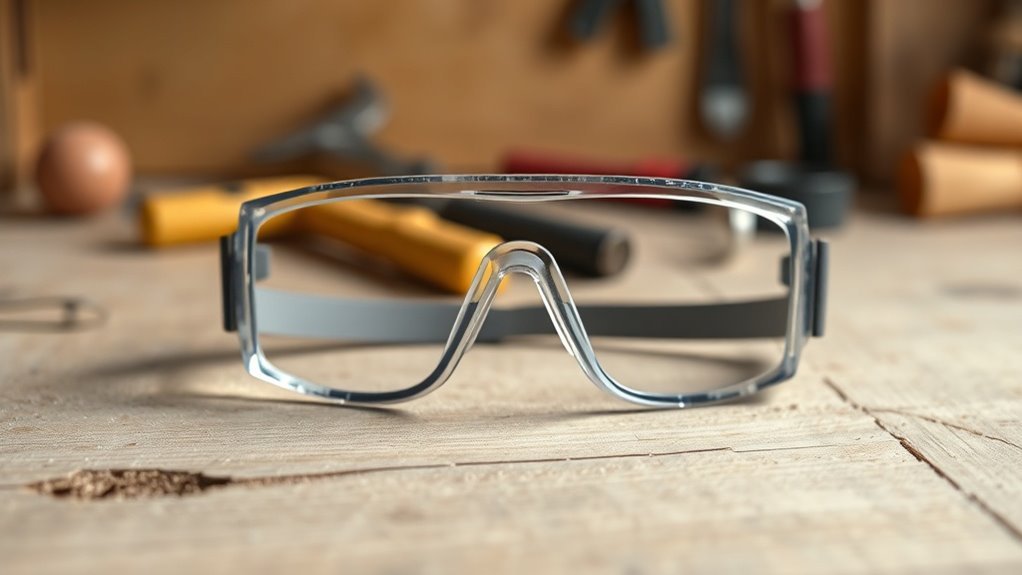
Safety goggles are a critical piece of gear that you shouldn’t overlook during a home renovation. Your eyes are especially vulnerable to dust, debris, and hazardous materials when you’re knocking down walls or using power tools. Wearing goggles protects your vision from potential injuries or long-term damage.
Choose goggles that fit snugly and provide a wide field of vision. Look for ones with anti-fog and scratch-resistant features to maintain clarity while you work. Additionally, selecting goggles with polycarbonate lenses can enhance impact resistance, making them particularly effective for various tasks.
Whether you’re cutting, sanding, or grinding, having a reliable pair helps keep your focus on the task at hand, rather than worrying about flying particles. Remember, it only takes a second for an accident to happen, so always prioritize your eye safety!
Hearing Protection
When you’re renovating your home, protecting your hearing is just as essential as protecting your eyes. There are various types of hearing protection available, from earplugs to earmuffs, each suited for different noise levels. Let’s explore why hearing safety matters and how the right gear can make a difference. Selecting the appropriate ear protection can significantly reduce your risk of hearing damage in noisy environments.
Types of Hearing Protection
As noise levels rise during home renovation projects, it becomes essential to protect your hearing.
You’ve got a few options when it comes to hearing protection. Earplugs are great for blocking sound; they’re compact and can be easily carried. Foam earplugs fit snugly in your ears, providing decent noise reduction.
On the other hand, custom-molded earplugs offer added comfort and effectiveness, though they can be pricier. Earmuffs are another option—perfect for those who find earplugs uncomfortable. They cover the entire ear, providing excellent noise isolation.
Some earmuffs even have built-in communication systems, allowing you to stay connected while you work. Whatever you choose, make sure it’s comfortable and appropriate for the type of noise you’ll encounter during your project.
Importance of Hearing Safety
Why is hearing safety often overlooked during home renovation projects? Many people don’t realize the long-term damage that loud tools and machinery can cause.
Prolonged exposure to high noise levels can lead to irreversible hearing loss, and once it’s gone, it’s hard to get back. You might think you can tolerate the noise, but even short bursts of loud sounds can affect your hearing over time.
That’s why wearing hearing protection, like earmuffs or earplugs, is essential. It’s an easy and inexpensive way to safeguard your hearing while you tackle your renovation tasks.
Dust Masks and Respirators
While renovating your home, wearing dust masks and respirators is vital for protecting your health. Renovation projects often generate harmful dust, debris, and fumes that can irritate your respiratory system. A simple dust mask might suffice for light projects, but if you’re dealing with more hazardous materials—like asbestos, mold, or strong chemicals—you’ll want a properly fitted respirator.
Check the specifications and choose a mask rated for your specific needs; some are designed to filter out fine particles, while others combat gases and vapors. Make sure to replace your mask or filters regularly for best protection. Remember, preventing respiratory issues starts with the right safety gear, so don’t skip this essential step in your renovation project. Additionally, understanding the risks associated with harmful dust and fumes can help you make informed choices about your respiratory protection options.
Hard Hats
When you’re working on home renovations, hard hats are essential for protecting yourself from overhead hazards.
There are different types of hard hats tailored for various environments, so knowing which one to choose can make a big difference.
Understanding proper usage guidelines guarantees you get the most protection while you work.
Importance of Hard Hats
Hard hats are a crucial safety tool during home renovation projects. They protect your head from falling objects, debris, and any unexpected accidents that could occur on-site.
When you’re working in tight spaces or at elevated heights, having this extra layer of protection can make a significant difference. It’s not just about compliance; it’s about safeguarding your health and well-being.
Wearing a hard hat also sets a professional tone for your project, signaling to others that safety is a priority. Remember, you mightn’t always see the hazards that come your way, but a hard hat helps you stay prepared.
Don’t take unnecessary risks—invest in a hard hat and keep your safety at the forefront of every renovation task.
Types of Hard Hats
Choosing the right hard hat can enhance your safety during renovation projects. Hard hats come in various types, each suited for different tasks and levels of protection. Here are some common types you might consider:
| Hard Hat Type | Features | Best Use |
|---|---|---|
| Class G | General electrical protection | Low voltage environments |
| Class E | Electrical insulation | High voltage environments |
| Class C | Lightweight, no electrical protection | General construction tasks |
| Type I | Top impact protection | Industrial work sites |
Each type has unique attributes, so consider your specific needs. Choosing the right hard hat not only protects you but also helps create a safer working environment.
Proper Usage Guidelines
To guarantee maximum protection from your hard hat, it’s vital to follow proper usage guidelines.
First, always make certain your hard hat fits snugly but comfortably on your head; it shouldn’t slip off during movement.
Check for any damage, such as cracks or dents, before each use—if you find any, replace it immediately. Adjust the inner suspension system for the best fit and comfort.
Always wear the hard hat when working in areas where there’s a risk of head injury, like above scaffolding or near machinery.
Avoid placing stickers or decals on it, which can weaken the material.
Finally, clean your hard hat regularly to maintain its integrity and effectiveness.
Work Gloves
While tackling home renovation projects, it’s essential to keep your hands protected, and that’s where work gloves come into play. Choosing the right pair not only prevents injuries but also improves your grip and dexterity. Additionally, understanding safety gear standards can help you choose gloves that meet required certifications for maximum protection.
Here are four types to take into account:
- Leather gloves: Great for handling rough materials and providing excellent durability.
- Insulated gloves: Perfect for electrical work, keeping your hands safe from shocks.
- Cut-resistant gloves: Ideal for projects involving sharp tools or materials, helping to prevent cuts.
- Waterproof gloves: Essential when working with wet materials like paint or adhesives, keeping your hands dry and clean.
Investing in quality work gloves can make a significant difference in your renovation experience.
First Aid Kit
Having a well-stocked first aid kit on hand is essential for any home renovation project since accidents can happen when you least expect them.
You should make sure your kit includes adhesive bandages, antiseptic wipes, gauze pads, and medical tape to treat common injuries like cuts and scrapes.
Sterile gloves will help prevent infections, while pain relievers can ease discomfort.
Don’t forget a pair of tweezers for splinters and scissors to cut bandages or tape.
It’s also smart to include a first aid manual to guide you through basic treatments. Carrying a first aid kit ensures you’re prepared for common injuries and emergencies that may arise during your projects.
Regularly check your kit to replace any expired items, ensuring you’re always prepared.
Fire Extinguisher
When you’re tackling home renovation projects, having a fire extinguisher nearby is essential, as unexpected sparks or accidents can ignite dangerous fires.
Make certain you know what kind of extinguisher to have on hand, as some are better suited for specific types of fires.
Here are four important things to take into account when choosing a fire extinguisher:
- Type of Fire Extinguisher: Look for Class A (ordinary combustibles), Class B (flammable liquids), or Class C (electrical fires) based on your project materials.
- Size: A 2 or 5-pound extinguisher is ideal for home use.
- Accessibility: Place it where you can easily grab it during an emergency.
- Maintenance: Regularly check the pressure gauge and expiration date to verify it’s ready when needed.
Questions
How Often Should I Replace My Personal Protective Equipment?
You should replace your personal protective equipment every few months or sooner if it shows signs of wear or damage. Regular inspections help guarantee your safety, and staying proactive minimizes risks during any project.
What Are the Signs of Wear in Safety Gear?
You should watch for frayed straps, holes, discoloration, or cracks in hard surfaces. If your gear no longer fits properly or shows significant wear, it’s time to contemplate replacement for your safety and protection.
Can I Use Disposable Masks Multiple Times?
You shouldn’t use disposable masks multiple times. They’re designed for single use to maintain effectiveness and protect you adequately. Reusing them can lead to exposure to harmful particles, compromising your safety during projects. Stay protected!
Do Hard Hats Expire?
Notably, studies show most construction-related head injuries occur from falls. Hard hats don’t fundamentally expire, but they should be replaced every 5 years, or sooner if damaged, to guarantee maximum protection while you work.
What Should Be in a Home Renovation First Aid Kit?
A home renovation first aid kit should include adhesive bandages, antiseptic wipes, gauze, medical tape, scissors, pain relievers, tweezers, and a cold pack. It’s also smart to have a first aid manual handy, too.
Conclusion
When diving into home renovation projects, remember that “an ounce of prevention is worth a pound of cure.” By equipping yourself with essential safety tools like PPE, safety goggles, and a first aid kit, you’re not just protecting yourself—you’re ensuring a smoother, safer experience. Don’t skimp on safety; it’s the foundation for any great project. With the right gear, you can tackle renovations with confidence, making your improvements both beautiful and risk-free. Stay safe out there!


